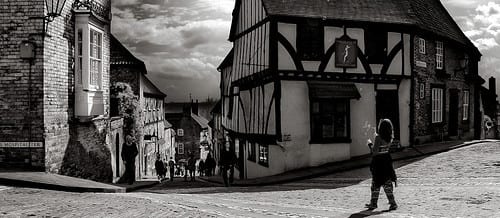Today, on our walk to draw a map we came across a very interesting and odd gargoyle on the cathedral. Like many Lincoln residents we have all seen the Cathedral probably hundreds of times, yet never noticed the interesting additions its stonework has to offer. This gave us the idea of doing a walking tour around the cathedral of the non conventional areas of attraction. By studying the Cathedral you notice there are more unconventional gargoyles are than you first imagine, even in the surrounding walls which we can presume to be religious symbolism. Even on the front on the cathedral there are images suggesting the devil or sinning as a deterrent to turn away from God to the onlookers of the Cathedral. The idea of doing a misguide, or maybe even just an audio walk I think would encourage people to look past the ordinary which is why we chose the cathedral, looking at the non-obvious aspects of a typical tourist attraction. Our idea was to emphasise the more ordinary or darker bits to the cathedral either based on fact or fiction.This idea is also spoken about in Making a performance: Devising Histories and contemporary practises chapter ten Between Routes and Roots: “The emphasis on localism in community theatre has done much to challenge the idea that there was one official history.” (Govan et al, 2007,138) The idea which springs from here is to challenge the facts that people cling to and perhaps change them completely or maybe even just slightly.
Changing facts completely is something that never occurred to me to do in sites so rich in history such as the Lincoln Cathedral. However, some of the suggestions from Tim Etchells ‘a text on..’ opened my eyes to the possibilities. Today we were asked to write something from the list we had heard and I chose ‘a text of obvious lies’ and due to the location where we were writing – I chose the Cathedral:
One day the people of Lincoln awoke to a very dark morning in the middle of summer.
Confused, they stepped out of their houses to see a huge building towering over Lincoln blocking out the morning sunlight.
The once empty field of grass on the top of the hill now housed a large Cathedral which seemed to have appeared overnight with no trace of where it could have come from.
Although clearly a lie and slightly ridiculous this instruction did lead me to think of possibilities once you step away from sheer facts and eventually inspired me to think of an audio walk with either slight shifts from the truth, or an emphasis on the less obvious attractions from a tourist place.
Making our own walk:
Although this was very challenging at first ideas soon became much clearer once we had decided our first destination for our walk. This then led us to view things differently that we had originally seen them before. For instance we stumbled across a wall and the only thing obviously different about it was the different bricks in one particular area, this however led us to develop an elaborate story as to why the bricks were different and soon devising a walk came quite easy.
Govan, E. Nicholson, H. Normington, K. (2007) Making a performance: Devising Histories and contemporary practises. Oxon: Routledge.
